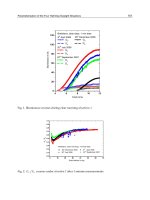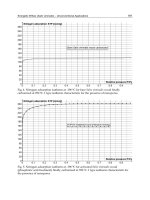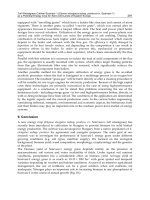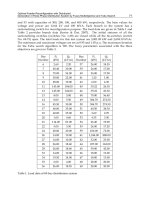Wind Energy Management Part 5 docx
Bạn đang xem bản rút gọn của tài liệu. Xem và tải ngay bản đầy đủ của tài liệu tại đây (2.49 MB, 13 trang )
Technical Framework Conditions to Integrate
High Intermittent Renewable Energy Feed-in in Germany
43
in Fig. 6 of a secondary controlled part-network within a total network can be given. In this
figure the ACE is the controlled variable, the steady-state primary and secondary controlled
part- and total network is the controlled system and the secondary control power of the
power plants are the manipulated variables. The controller itself is the integral acting
secondary control, which splits into the different control reserve ranges of each contributing
power plant of the secondary control according to the coefficients c
i
. The operating point
“scheduled power” of the power plants is created by the exchange power schedule of the
part-network and the hourly load forecasts as well as by the forecasts for the renewable
energy generation. The forecasts of the renewable energy generation are commonly
differentiated into the day-ahead and intra-day forecasts to minimize the final forecast error
as far as possible. The schedules of all power plants are generated according to the demand
and supply characteristic which is traded via the European Energy Exchange (EEX) in
Germany. This process is described by the tertiary control. The forecasts and forecast errors
of the load and the renewable energy generation compose the so called “residual load”. The
sum of all forecast errors results in the disturbance variable of the controlled system.
Therefore it is the job of the secondary control to automatically compensate the disturbance
variable. If in the future this disturbance variable will increase due to the increased fraction
of renewable energy sources within the system the actively controlling conventional power
plants have to be designed for high control reserves and therefore higher ramping rates.
This will cause higher stress and thermodynamical wear and it will increase the
maintenance costs. Hence the undisturbed part-networks do not contribute to this control
because indeed their exchange power P
TA
and the network frequency will change but with a
well conditioned k
T
≈ 1/σ
T
both paths “primary controlled part-network 1/σ
T
“ and the
network coefficient network controller k
T
compensate each other and therefore the ACE
T
remains zero.
In Fig. 7 the principle of operation of the secondary control with steady-state primary
control is shown for a total network that consists of two identical part-networks 1 and 2. In
part-network 1 occurs in the left case a step-shaped and in the right case a sine-shaped
disturbance of 0.01 pu. In the case of the step-shaped disturbance the frequency deviation
amounts to:
4
1
1
0.01 0.5 0.14 7 10 35
V
T
TG
G
P
fp p
uoder mHz
P
(12)
The ACE
T1
(blue line) is changed according to the disturbance in the first moment and
returns back to zero after the secondary control p
TS
has reacted and compensated the
disturbance. Whereas the signal ACE
T2
(red line) remains zero during this process. In the
first moment part-network 2 supports the compensation of the disturbance by the use of the
frequency deviation and the primary control by delivering an exchange power of 5 × 10
-3
pu
to the part-network 1 (red line). Therefore part-network 1 receives this power of -5 × 10
-3
pu
shown by the blue line.
The sine-shaped excitation is used to illustrate the influence of the forecast error of the
renewable energy production and the consumers onto the secondary control: A permanent
frequency deviation occurs and the part-network 1 is continuously delivering secondary
control reserves by its power plants (blue line) which will lead to increased wear in these
plants. Besides the undisturbed part-network 2 continuously delivers an oscillating amount
of power by the use of the primary control (red line). So the power plants of these
Wind Energy Management
44
undisturbed control areas are stressed and wear at a higher extent, too. This effect is even
higher as much more the acceleration time constant is reduced.
Fig. 6. Control oriented scheme of the secondary control
Technical Framework Conditions to Integrate
High Intermittent Renewable Energy Feed-in in Germany
45
0 100 200 300 400 500 600 700 800 900
-0.01
0
0.01
delta pTV
Time in s
0 100 200 300 400 500 600 700 800 900
-1
0
1
x 10
-3
delta f in pu
Time in s
0 100 200 300 400 500 600 700 800 900
-0.01
0
0.01
-delta ACE in pu
Time in s
0 100 200 300 400 500 600 700 800 900
-0.01
0
0.01
pTS in pu
Time in s
0 100 200 300 400 500 600 700 800 900
-0.01
0
0.01
delta pTA in pu
Time in s
0 100 200 300 400 500 600 700 800 900
-0.01
0
0.01
delta pTV
Time in s
0 100 200 300 400 500 600 700 800 900
-1
0
1
x 10
-3
delta f in pu
Time in s
0 100 200 300 400 500 600 700 800 900
-0.01
0
0.01
-delta ACE in pu
Time in s
0 100 200 300 400 500 600 700 800 900
-0.01
0
0.01
pTS in pu
Time in s
0 100 200 300 400 500 600 700 800 900
-0.01
0
0.01
delta pTA in pu
Time in s
Fig. 7. Principle of operation of the secondary control if a step-shaped (left) and a sine-
shaped (right) disturbance occurs
3.3 The tertiary control
The primary task of the tertiary control is the allocation of power into the power plant
schedules of a part-network according to the forecasts for the load, for the renewable energy
generation and the exchange schedules with other part-networks. In this context it is not a
kind of automatic control like the secondary control because these schedules are generated
on the basis of stock exchange contracts at the EEX. The control oriented structure of the
tertiary control is shown in Fig. 8.
The main task of the players that trade the electrical energy at the EEX is to minimize the
costs of generation and to maximize the profit. Therefore it is attempted to minimize the
losses and at the same time ensure the safety of supply. This means amongst other issues
that the secondary control signal returns back to zero at the end of each quarter-hour.
Furthermore the forecasts for the load and the renewable energy generation have to be
refreshed continuously and the exchange schedule with other part-networks must be
ensured. Therefore the inadvertent exchange power of every week has to be included into
the next-week delivery in such a way that all MWh are compensated. Here the controlled
system is the “primary and secondary controlled part-network” which is disturbed by the
load curves and the real renewable energy generation. The manipulated variables are the
schedules of each conventional power plant which can be adjusted with a quarter-hour
resolution. In addition to these adjustments of the scheduled power output even warm and
cold start-up cycles of conventional power plants can occur to follow the intermittent
renewable power feed-in in a complementary way.
This kind of dynamical operation will increase in the future if more and more uncontrolled
renewable power feed-in is added to the system. Therefore the effect of this higher dynamic
and more pretentious flexibility requirements are discussed in the next sections.
Wind Energy Management
46
Fig. 8. Control oriented scheme of the tertiary control
Technical Framework Conditions to Integrate
High Intermittent Renewable Energy Feed-in in Germany
47
4. Power plant scheduling and technical limitations of conventional power
plants
To analyze the intermitting power sources and to simulate the influence onto the
conventional Thermal Power Plants (TPP) several simulation models are necessary. The
network control was described in detail in the previous sections. In this section particularly
the power plant scheduling model will be described with some more details. To have a more
precisely formulation of the associated equations please take look at the references
mentioned in the text.
The so called unit commitment models can be used to simulate the power plant scheduling,
e.g. the tertiary control, to take care of general technical parameters of thermal power plants
like minimum up- and downtimes, minimum power output and ramping rates, reserve
capacities and time dependant start-up costs. Today often these models have a Mixed-
Integer Linear Programmed (MILP) optimization structure that uses commercial solver
engines like IBM CPLEX to calculate the schedules of the fossil and nuclear power plants
using variable time resolutions usually set to a one or a quarter-hour. In these models the
spinning reserves for primary and secondary control and the non-spinning reserves for the
tertiary control have to be considered. Fig. 10 gives an overview of the different types of
power reserves.
To give an example for such a scheduling process for an existing thermal generation system
the power plant parameters for the following scenarios were set to realistic values that hold
for most of the German power plants. These values were determined with the help of the
five biggest power plant operators in Germany and Dong Energy from Denmark as well as
the combined cycle power plant (CCPP) operator “Kraftwerke Mainz-Wiesbaden (KWM)”
in Mainz (Germany) within the research project “Power plant operation during wind power
generation” – the “VGB Powertech” research project No. 333. The “VGB Powertech” is the
holding organization for more than 460 companies from the power plant industry in 33
countries especially in Europe.
Fig. 9. Overview of the different types of generation sources for the scheduling simulations
shown in this section
Wind Energy Management
48
For the following scenarios the simulations include estimation models for the wind and
photovoltaic time series as well as time series to take care of the Combined Heat and Power
(CHP) stations whose electrical output power normally depends on the outside temperature
and therefore the heat demand and which will have heavy influence onto the remaining
must-run power and inertia as well as the resulting residual load that has to be covered by
dispatchable power stations.
Therefore Fig. 9 gives a general overview of the different types of power plants and energy
sources within the simulations. In this diagram two main boundary conditions must be
observed at any time. The first is the active power balance stated in equation (13) between
dispatchable generation and the residual load, the second one is the observation of the
availability for the different types of reserve power as stated in equation (14).
Constants
()
rt
Rt
Total reserve of type rt in
period t
()RL t
Residual load demand in
period t
Sets
U
Set of indexes of the
generating units
T
Set of indexes of the time
periods
RT
Set of indexes of the
different reserve types
Variables
()
fu
u
ct
Production cost of unit u in
period t
()
su
u
ct
Start-up cost of unit u in
period t
()
sd
u
ct
Shut-down cost of unit u in
period t
()
u
p
t
Power output of unit u in
period t
() (),
u
uU
pt RLt t T
(13)
() (), ,
rt rt
u
uU
p
tRt tTrtRT
(14)
Due to the huge number of flexible units in such models, here more than 150 units, and a
time horizon of one or more days with a an hourly resolution (here 36 hours), the number of
overall binary variables can be reduced by using an efficient formulation of the different
boundary conditions as stated in Carrión et al. (2006) under consideration of equations from
Arroyo et al., (2000). A detailed description of all equations used for the simulations shown
here can be found in these two references to describe all aforementioned technical
constraints of the conventional power plants. The equations were slightly adjusted to the
assumption described in this section but the basic structure was not changed at all.
For similar approaches where MILP structures are used to solve the unit commitment
problem even under consideration of security constraints and simplified transmission line
capacities see Streiffert et al. (2005), Delarue et al. (2007) and Frangioni et al. (2009).
4.1 Consideration of the different types of reserve power
As mentioned before the reserve power is considered as well within the scheduling process.
Therefore there are different classes and types of reserves for different purposes with
different response times.
Technical Framework Conditions to Integrate
High Intermittent Renewable Energy Feed-in in Germany
49
The reserves can be divided into two classes – the spinning and the non-spinning reserves as
shown in Fig. 10. Spinning reserves are available in the aforementioned inertia of the rotors
of the directly synchronized generators. The reserve provided by the accelerating power of
the directly synchronized inertia responds immediately to any active power disturbances.
The second class of reserves – the non-spinning reserve – is provided by generators that can
be online or offline but ready to start up within 15 minutes. Usually this tertiary or so called
minute reserve is provided by gas turbines or Combined Cycle Power Plants (CCPP).
These different types of reserves are necessary to guaranty the stable operation of the
generation system and to respond to outages of generation units or changes in the power
demand.
Fig. 10. Classes and types of different power reserves
Unfortunately due to the intermittent character of solar and wind power these energy
sources are uncertain and so they are forecasted depending on meteorological
measurements and forecasting models. These models always have forecast errors but they
were enhanced intensively within the last years. These forecast errors can be divided into
two types, the day-ahead or long-term errors and the intra-day or short-term errors.
Normally the intra-day errors are noticeable smaller than the day-ahead errors because the
forecast horizon is much smaller. The average forecast errors are usually characterized by
the root-mean-squared-error (RMSE), which was between 3.7 and 5.8 % in 2010 for day-
ahead and about 2.7 % for average intra-day forecasts in Germany according to information
of the German Transmission System Operators (TSOs).
Wind Energy Management
50
4.2 Objective function for the tertiary control optimization process
As shown in Fig. 9 the power plants are divided into dispatchable and non-dispatchable
generation. Normally only the power plants that belong to the dispatchable generation are
able to fulfil the network control requirements. This means their operation point as well as
the amount of primary and secondary control reserves are optimized by an optimization
process so that the total operational costs are minimized as stated in equation (15). These
operational variable costs split into fuel costs on the one hand and start-up and shut-down
costs on the other hand.
() () ()
fu
su sd
uuu
tTuU
M
inimize c t c t c t
(15)
electrical power output in MWelectrical power output in MW
Fig. 11. Simulated schedule with reserved control areas for primary and secondary control
for a single power plant
This kind of optimization problem is commonly known as the unit commitment problem.
For simplification the fuel costs often are modelled by a step-wise linear production cost
curve for partial loads of conventional power plants. For the scenarios shown here the
partial production cost curve is divided into maximal three segments. The detailed
equations used and adjusted for modelling such step-wise functions as well as equations for
start-up and shut-down costs and ramping rates are stated in Carrión et al. (2006), but in
addition to the reserve stated there, the scenarios here consider a detailed allocation of the
different types of spinning and non-spinning power reserves, too. This means that the
amount of reserve power for primary and secondary control as well as a dynamical reserve
for forecast errors is determined for each station that is online. By considering these
Technical Framework Conditions to Integrate
High Intermittent Renewable Energy Feed-in in Germany
51
spinning reserves in each station, the resulting must-run power that can’t be undercut is
determined by the optimization process.
Fig. 11 shows the result of such an optimization for a certain single power plant. Here the
area with the reserved power for the primary and secondary control is illustrated for each
hour. In this diagram the scheduled power output of the plant for each hour is the power
value which belongs to the top of the green area. Therefore only the range of the green area
can be used to correct the schedule in the negative direction without a change of the online
state of the plant. In the positive direction the maximum possible correction is limited by the
rated power output of the plant.
4.3 Exemplary scenarios for 2020 of the power plant scheduling process
To simulate a future power plant scheduling scenario it is necessary to generate some
reasonable input time series for the different types of non-dispatchable generation.
Therefore Fig. 12 shows an exemplary behavior of this non-dispatchable generation. Such
time series are used in the following scenarios for different seasons of the year.
0
10
20
30
40
50
60
70
80
90
Power in GW
Run-of-River
Feed-in from CHP
Offshore wind
Onshore wind
Photovoltaics
Total network load
Fig. 12. Non-dispatchable power feed-in for a two weeks summer period in 2025
Fig. 13 and Fig. 14 show the accumulated results of the power plant scheduling for two
different scenarios. The first scenario is a typical winter scenario showing the situation in
Germany today. In Fig. 13 the typical types of operation modes for base, medium and peak
load are clearly visible. Herein the nuclear and lignite power plants are almost operated as
base load. The hard coal power plants provide the medium load and the gas and pumped
storage capacities (PSPS) support the peak load. In this scenario no offshore wind capacities
were defined. Due to the high district heating demand in a winter period the CHP-fraction
in this scenario is relatively high.
Wind Energy Management
52
Fig. 13. 7 days period – winter scenario 2010 without import/export capability
Fig. 14. 7 days period – winter scenario 2020 with import/export capability
In the second scenario, shown in Fig. 14, a 7 day period illustrates a typical high wind at
load low load scenario for a winter weekend as expected for 2020. In this scenario the lignite
power plants are operated on a very low partial load during the weekend. They ramp up to
their nominal output at the end of Sunday (the 5th day) because the wind power feed-in
decreases massively at the end of this weekend. At this time several power plants have to
start-up as well.
The fraction of nuclear power was reduced due to the high probability of a nuclear phase-
out in Germany. The CHP-fraction in this scenario is relatively high because of the high
demand for district heating in the winter period.
Due to the limited storage capabilities of the pumped storage power plants and the limited
power transmission line capacities to the German neighbour countries it could be possible
that a certain amount of renewable energy could not be integrated into the system with
today’s storage capacities. This amount of energy respectively the excess power is identified
Technical Framework Conditions to Integrate
High Intermittent Renewable Energy Feed-in in Germany
53
by the model as power surplus shown in Fig. 14. In reality today there are about 10 GW of
transmission line capacities, but how much of these capacities will be available in such a
high renewable feed-in scenario depends on the renewable power feed-in in the other
countries. This problem has still to be investigated in furthermore studies.
By the use of such power plant schedules in addition to certain disturbance signals to
simulate the non-predictable deviations of the forecasts for the consumer and the renewable
energy generation it is possible to determine the life time consumption of different highly
stressed components of single power plants. Therefore a detailed model of each power plant
is necessary to simulate the exact thermodynamical behaviour. The methods for such
investigations are discussed in the next sections.
5. Life time consumption and life time improvements of conventional fossil
power plants
In a future power grid with high renewable power feed-in, especially from wind power, it
becomes more important as well as economically beneficial for conventional power plants to
be able to adjust the production in order to balance the renewable energies. But due to the
long life time, the majority of current power plants have been designed decades ago mainly
for steady state operation. Consequently, the focus was put more on reliability and
preservative operation than on high dynamics.
The recent and ongoing changes in the energy market in Germany will lead to an increased
number of start-ups and load changes, which cause additional life time consumption.
Improvements of the existing technologies are required to enable higher dynamics at limited
additional stress during transient operation.
This is especially true for coal fired power plants because of the fuel pulverization in coal
mills. These mills have a slow and often unknown dynamic and limit the ramping rates of
coal fired units. Additionally, the boiler itself shows a slow transient response due to its big
metal and water masses as well as uncertainties like degradation of the heat transfer due to
ash build up on the heating surfaces. To overcome this, the ramping rates are made
sufficiently slow.
Improvements to this conservative approach could be achieved by the use of advanced
control systems, e.g. state observers and model based control systems or additional sensors,
like for example coal dust measurement (Dahl-Soerensen, M.J./Solberg, B., 2009).
For the evaluation of such optimizations of the process and the control system, computer
aided simulation of the power plant process could be a powerful tool.
5.1 Methods for simulation
In order to judge the expected impacts of a more dynamic power plant operation a detailed,
transient model consisting of one-dimensional or lumped interlinked sub models, based on
thermodynamic fundamental equations, has been created. A 550 MW hard coal power plant,
that started its operation in 1994, has been used as a reference. This power plant represents
the state of the art and is due to its long rest life time heavily effected by future changes of
the energy market.
The focus of the investigation has been put on the water-/steam circuit, the combustion
chamber of the steam generator and the fresh air passage with the coal mills, as well as their
Wind Energy Management
54
dynamics and the influence of different operation modes on distinct devices e.g. thick-
walled headers and turbine shafts.
A simplified schematic of the model is shown in Fig. 15. Indicated are the feed water pumps,
high pressure preheaters (HPP), the steam generator, the different turbine stages, as well as
the forced draft and mill fan, the air preheater and the coal mills. The low pressure
preheaters (LPP) are not part of the power plant model, since they are not highly stressed,
due to their low temperature level.
firing
exhaust gas
coal
fresh
air
forced
draft fan
steam air
preheater
mill fan
air
preheater
coal mills
economizer
reheater 1
superheater 3
reheater 2
superheater 4
superheater 2
superheater 1
HP
IP
LP
feed water
pump
HPP
HPB
IPB
evaporator
circula-
tion
pump
cyclone
start bottle
to condensor
from
feed water
tank
to LPP
air
preheater
Fig. 15. Structure of the power plant model
For making simulation-based statements about the influence of different power plant
operation modes the thermodynamical model is coupled to a reduced copy of the power
plant control system.
The modeling is conducted in Modelica (Casella et al., 2003, Casella et al, 2005, Fritzson,
2004) using the simulator Dymola®. The modeling with Modelica is characterized by its
modular concept.
5.2 Methods for evaluation of life time consumption
With this model it is possible to predict temperatures and temperature gradients at points
which are inaccessible to measurements like wall temperatures of highly stressed
components.
For the first 90 minutes of a soft start the occurring wall temperatures of the superheater 2
outlet header are displayed in Fig. 16. Obviously the metal temperature at the outside of the
wall follows the inner temperature with a certain delay and its amplitudes are considerably
Technical Framework Conditions to Integrate
High Intermittent Renewable Energy Feed-in in Germany
55
smaller. This effect can be explained with time specifics of the heat conduction. The
noticeable phase shift of the temperatures leads to relative high temperature differences
between the inner and outer phase in case of sharp edged changes in evaporator heating or
cooling.
The evaluation of metal temperatures offers the possibility to benchmark different controller
parameter sets with a view to preserving operation at concurrently high load dynamics.
Quantification of the effects of thermal stress on the different components of a plant is a
challenging task as the processes of fatigue are complex and highly statistical. For this
reason the results of a fatigue prediction in this context can only be of qualitative nature and
should be understood as a trend indicator that is capable of identifying the most stressed
components and predict possible side effects of innovative control strategies on this complex
system. For a detailed investigation of certain components a FEM-analysis considering the
installation situation (and with it possible pretensions in the component) and the exact
geometry should be taken into account.
Fig. 16. Metal temperatures in the SH 2 outlet header
However, for a first estimation of the effects of future more dynamic plant operation two
different approaches are used and should be discussed in the following:
The guidelines of the Deutsche Dampfkesselausschuss (2000) TRD 301 and 508 give directives
for the estimation of fatigue of thick-walled boiler components under smoldering pressure
and temperature due to start-up processes.
For this purpose an effective stress range is evaluated with a Wöhler-diagram for crack
initiation. The following equation gives the law for calculating the stress range ∆
σ.









